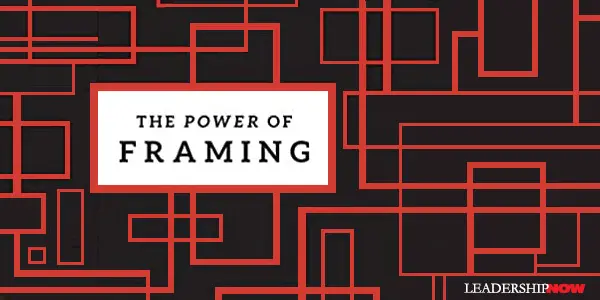 |
 |
01.10.11

The Power of Framing
“Language becomes a key issue not just in our own sensemaking, but in how effectively we impact the sensemaking of others,” writes Gail Fairhurst. As leaders, we recognize that we cannot accomplish our objectives on our own, so this becomes important when we are trying to align the interests of others with our own. The Power of Framing by Gail Fairhurst is about understanding the meaning—the shared reality—created in our communication. Paraphrasing Michel Foucault, she writes, “people know what they say, and they usually know why they say what they say. What they do not understand is what they say does. The Power of Framing is an essential leadership book that will help us to understand the context-shaping features of our language so that we can then better manage the meaning of our communication. Recently, we have seen many examples of leaders creating unintended “realities” from the content of their communications alone that only served to make a big problem, bigger.People with the skills to communicate reality in a meaningful way often emerge as leaders, she observes. What we often fail to consider, is that when communicating, we are not just reacting to the environment; we actually shape or create it by how we interpret and talk about it. Being conscious of our framing then becomes critical. Self-awareness plays a major role in framing our communication to have the impact we intend. She begins by presenting six guiding rules for constructing reality: Rule 1: Control the Context. Leaders often cannot control events, but they can control the context under which events are seen if they recognize a framing opportunity. Rule 2: Define the Situation. At its most basic level, framing reality means defining “the situation here and now” in ways that connect with others. Rule 3: Apply Ethics. “Reality” is often contested. Framing a subject is an act of persuasion by leaders and imbued with ethical choices. Rule 4: Interpret Uncertainty. It is the uncertainty, confusion, and undecidability of “the situation here and now” that opens it up for interpretation and provides an opportunity for the more verbally skilled among us to emerge as leaders. Rule 5: Design the Response. Ultimately, leadership is a design problem. Leaders must figure out what leadership is in the context of what they do and, through framing and actions, persuade themselves and other people that they are doing it. Rule 6: Control Spontaneity. Effective framing requires that leaders be able to control their own spontaneous communications. With these rules in mind, Fairhurst explores framing as a skill that leaders must master to communicate vision and set priorities, a science that shows leaders how to think on their feet and frame on the spot, an art form that leaders must hone like a craft with story, metaphor, argument, and visual images as their primary tools, a set of emotions that leaders must deploy to complement their message and as an ethical response in order for leaders to achieve and maintain believability. As a science she explains the concept of priming for spontaneity. It’s more than just thinking through what you want to say in a given situation. It involves thinking through your mental models. She writes, “If you take the time to consciously and periodically think through your mental models as a leader, you are priming your unconscious to select and interpret new information using the models as a reference point.” What we say reflects our thinking and view of the world. Emotions are a part of leadership and emotional intelligence is required for framing. When emotions are running high you have an opportunity for framing. “Emotional regulation is a part of emotional intelligence, and two framing concepts play a role in this regard,” says Fairhurst. “Priming for spontaneity can assist in controlling one’s emotions in advance of a situation if one envisions a wide range of responses are likely to occur. Also, framing after the fact, or reframing, allows leaders to correct the emotionally charged messages they wish to modify.” In regards to ethics, she reminds us that “how we frame is a window into our ethics whenever we act in a leadership capacity.” This is closely tied to the concept of priming. We reflect and communicate our mental models in all that we do. To use in conjunction with this book, Fairhurst has created some valuable downloadable framing tools. There are links to additional resources for specific topics raised in each chapter, including films, documentaries, news clips and PowerPoint teaching slides. 
Posted by Michael McKinney at 11:52 AM
|
BUILD YOUR KNOWLEDGE


How to Do Your Start-Up Right STRAIGHT TALK FOR START-UPS 
Grow Your Leadership Skills NEW AND UPCOMING LEADERSHIP BOOKS 
Leadership Minute BITE-SIZE CONCEPTS YOU CAN CHEW ON 
Classic Leadership Books BOOKS TO READ BEFORE YOU LEAD |